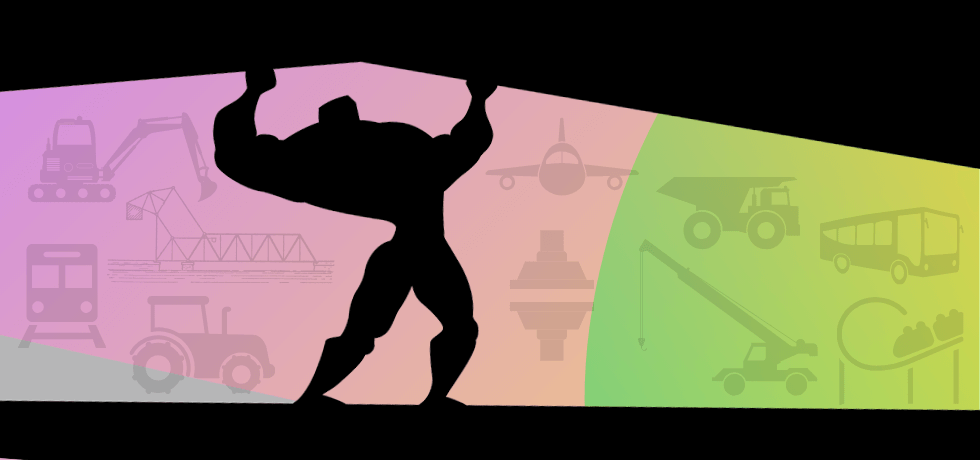Living With Hydraulics & How It Gave Us Superhuman Strength

Whether you know it or not, hydraulics actually gave us superpowers that we use every day. This impressive technology improved the way we work, making us faster and smarter. And although we use hydraulics in several ways, we never really give its due credit.
It’s not even that we take it for granted. Hydraulics are so intertwined in our daily lives and heavily relied upon that we simply forget just how remarkable this science really is.
This is why we’re going to take a moment to give it proper recognition and appreciate the power we have because of hydraulics.
Shedding A Spotlight: Our Superhuman Strength
Unbeknownst to the everyday Joe Shmoe, applications for hydraulics are versatile and widespread – For example, we now have the ability to:
- Build taller, bigger buildings
- Operate stronger cranes that lift higher
- Use dump trucks to quickly haul more materials
- Ride high-speed trains that travel faster
- Fly planes that soar even higher
These examples are just a few things we see or use on a regular basis – And it doesn’t stop there!
Hydraulic systems have become a major part of our lives because virtually every industry employs hydraulics to move machinery or manufacture goods.
Living Our Best Lives With Hydraulics
The human race has evolved over time with innovative technologies and hydraulics contributed to one that propelled us several steps forward over the last couple of centuries.
We now have machines and equipment that help:
- Feed us using tractors to help grow food
- Provide shelter with construction equipment to build homes & offices
- Transport us swiftly and safely in buses, trains & planes
- Make our lives easier & more enjoyable with manufactured goods
Without hydraulics, we’d still be working harder and not smarter. But to fully appreciate fluid power (aka hydraulics), let’s delve a little deeper into the science of things.
Defining The Science Of It All
We see hydraulic cylinders and instinctively know what they are, but how many people actually understand what they really are, how, and why they work?
Merriam-Webster’s Dictionary defines Hydraulics as:
A branch of science that deals with practical applications (such as the transmission of energy or the effects of flow) of liquid (such as water) in motion.
Source: Merriam-Webster, 2012
In other words, hydraulics is a science that leverages the energy from a fluid (gas or liquid) for practical use in our everyday lives.
The use of fluid pressure as a source of energy is the main reason why we have “superhuman” strength to lift things that we couldn’t possibly lift manually by ourselves – we’ll get into how this is possible in a few, but let’s jump back in time to learn more about the minds that pondered about this science.
Pascal’s Principle: Why Superhuman Strength Is Possible
Great minds started thinking about hydraulics thousands of years ago. Aristotle started experimenting with it in 384-322 B.C. and Archimedes first started to quantify and test concepts and theories in 287-212 B.C.
Many other European scientists followed suit afterward contributing to hydraulics’ evolution including Da Vinci, Mariotte, and Boyle.

But the person who discovered the main principle (of fluid pressure as a source of energy) was French scientist Blaise Pascal, who studied math and physics.
His body of work included the study of:
- Atmospheric Pressure
- Conic Sections and
- Principles of Hydrostatics
He established the basic rule of hydraulic power, now universally known as Pascal’s Principle or Pascal’s Law, which states the following regarding fluid mechanics:
When a fluid is at rest in a closed container, a pressure change in one part is transmitted without loss to every portion of the fluid and to the walls of the container.
Source: Pascal’s Principle, Encyclopaedia Britannica, 2012
To see Pascal’s Principle in use, let’s refer to the illustration below of a hydraulic press lifting a car.
According to Pascal’s Principle using the above illustration:
The original Pressure (P1) exerted on the small piston (A1) will produce an equal pressure (P2) on the large piston (A2).
However, because A2 has 10x’s the area of A1, it will produce a force (F2) that is 10x’s greater than the original force (F1).
Which means, when pressure is exerted on a fluid, it is equally distributed throughout the fluid. Therefore, fluid can transmit power.
Since hydraulics use incompressible liquids, the pressure applied from one end (the original force used on the left) is equal to the desired pressure on the other end (or the right side).
A Tribute To An Innovative Technology
Without hydraulics, we would have been physically limited to manual lifting and digging using wedges, inclines, levers, and pulleys.
But thanks to some brilliant minds who wanted to understand the power of fluid, we gained super strength to move and lift things that were not humanly possible until we discovered hydraulics.






